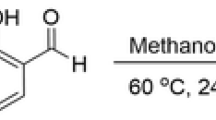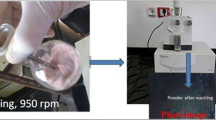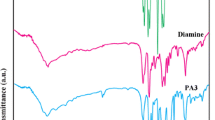Abstract
The homopolymerization of o,m,p-aminobenzenesulfonic acid (o,m,p-ABS) has been a challenging act because of the strong electron withdrawing nature of the sulfonic acid group (-SO3H). Therefore, polymerization was done by either sulfonating of polyaniline (PANI) or copolymerization of the corresponding monomers with aniline. In this study, we reported a novel method for the preparation of nanopolymer from m-ABS as monomer using FeCl3.6H2O as a binary oxidant and dopant agent in ratio of oxidant to the monomer equal to 5 ([Ox]/[M] = 5) in the solvent-free (solid-state) condition at 40–45 °C for 24 h and the yield of reaction was 46%. The polymer was characterized by a number of techniques such as Fourier transform infrared, ultraviolet-visible, atomic absorption, elemental analysis, thermogravimetric analysis, differential scanning calorimetry, X-ray diffraction, four probe conductimeter, and zeta potential. The morphology was determined by scanning electron microscopy, transmission electron microscopy and atomic force microscopy and particles size were found about 30–65 nm. The zeta potential by dynamic light scattering (DLS) at two concentrations of 0.20 g/l and 0.05 g/l was measured −61.7 mV and − 43.7 mV, respectively. It showed that the polymer has very good stability and it shows no coagulation and flocculation. The molecular weight was obtained by intrinsic viscosity [η], gel permeation chromatography, static light scattering (SLS) and DLS. The very high molecular weight was obtained by DLS, SLS and [η]. Mn and Mν were equal to 5200 kg/mol and 2173 kg/mol, respectively. The new mechanism based on para-head-to-tail polymerization was introduced explained poly (m-ABS) new structure containing Fe and the high molecular weight. This polymerization method was simple, effective and inexpensive, use of Lewis acid (FeCl3) for both doping and oxidation, as well as resolving the need for high pressure and a long time for dialysis and has the merits of green and solvent-free (solid-state) condition. At the best of our knowledge, this report of polymerization of m-ABS is the most efficient method that has been reported so far.














Similar content being viewed by others
References
Teasdale P R, Spinks G M, Kane-Maguire L A, Wallace G G (2008). Conductive electroactive polymers: intelligent polymer systems. CRC press
Freund M S, Deore B A (2007) Self-doped conducting polymers. Wiley
Eftekhari A (2011) Nanostructured conductive polymers. Wiley
Modarresi-Alam AR, Amirazizi HA, Movahedifar F, Farrokhzadeh A, Asli GR, Nahavandi H (2015) The first report of polymerization and characterization of aniline bearing chiral alkyl group on ring via a covalent bond; poly [(±)-2-(sec-butyl) aniline]. J Mol Struct 1083:17–26
Movahedifar F, Modarresi-Alam AR (2016) The effect of initiators and oxidants on the morphology of poly [(±)-2-(sec-butyl) aniline] a chiral bulky substituted polyaniline derivative. Polym Adv Technol 27:131–139
Modarresi-Alam AR, Zafari S, Miandashti AR (2015) A facile preparation method for synthesis of silica sulfuric acid/poly (o-methoxyaniline) core-shell nanocomposite. Polym Adv Technol 26:645–657
Farrokhzadeh A, Modarresi-Alam AR (2016) Complete doping in solid-state by silica-supported perchloric acid as dopant solid acid: synthesis and characterization of the novel chiral composite of poly [(±)-2-(sec-butyl) aniline]. J Solid State Chem 237:258–268
Koosheh HB, Modarresi-Alam AR (2016) Solid-state synthesis of a new core-shell nanocomposite of polyaniline and silica via oxidation of aniline hydrochloride by FeCl3.6H2O. Polym Adv Technol 27:1038–1049
Wang Z, Qiang H, Zhang C, Zhu Z, Chen M, Chen C, Zhang D (2018) Facile fabrication of hollow polyaniline spheres and its application in supercapacitor. J Polym Res 25:129 (1-7)
Gerard M, Chaubey A, Malhotra B (2002) Application of conducting polymers to biosensors. Biosens Bioelectron 17:345–359
Roy BC, Gupta MD, Bhowmik L, Ray JK (1999) Studies on water-soluble conducting polymer: Aniline initiated polymerization of m-aminobenzene sulfonic acid. Synth Met 100:233–236
Yue J, Epstein AJ (1990) Synthesis of self-doped conducting polyaniline. J Am Chem Soc 112:2800–2801
Yue J, Wang ZH, Cromack KR, Epstein AJ (1991) MacDiarmid AG. Effect of the sulfonic acid group on polyaniline backbone. J Am Chem Soc 113:2665–2671
Rong G, Zhou D, Pang J (2018) Preparation of high-performance antifouling polyphenylsulfone ultrafiltration membrane by the addition of sulfonated polyaniline. J Polym Res 25(66):1–8
Ginder J, Epstein A (1990) Role of ring torsion angle in polyaniline: electronic structure and defect states. Phys Rev B 41:10674–10685
Krishnamoorthy K, Contractor A, Kumar (2002) A electrochemical synthesis of fully sulfonated n-dopable polyaniline: poly (metanillic acid). Chem Commun (3):240–241
Márquez AGC, Rodríguez LMT (2007) Rojas AM. Synthesis of fully and partially sulfonated polyanilines derived from ortanilic acid: an electrochemical and electromicrogravimetric study. Electrochim Acta 52:5294–5303
Kitani A, Satoguchi K, Tang HQ, Ito S, Sasaki K (1995) Electrosynthesis and properties of self-doped polyaniline. Synth Met 69:129–130
Shimizu S, Saitoh T, Uzawa M, Yuasa M, Yano K, Maruyama T, Watanabe K (1997) Synthesis and applications of sulfonated polyaniline. Synth Met 85:1337–1338
Mav I, Žigon M, Šebenik A, Vohlidal J (2000) Sulfonated polyanilines prepared by copolymerization of 3-aminobenzenesulfonic acid and aniline: the effect of reaction conditions on polymer properties. J Polym Sci A Polym Chem 38:3390–3398
Fan JH, Wan MX, Zhu DB (1999) Synthesis and properties of aniline and o-aminobenzenesufonic acid copolymer. Chin J Polym Sci 17:165–170
Neoh K, Kang E, Tan K (1993) Co-existence of external protonation and self-doping in polyaniline. Synth Met 60:13–21
Fan J, Wan M, Zhu D (1998) Synthesis and characterization of water-soluble conducting copolymer poly (aniline-co-o-aminobenzenesulfonic acid). J Polym Sci A Polym Chem 36:3013–3019
Yang CH, Huang LR, Chih YK, Chung SL (2007) Simultaneous molecular-layer assembly and copolymerization of aniline and o-aminobenzenesulfonic acid for application in electrochromic devices. J Phys Chem C 111:3786–3794
Xu Y, Dai L, Chen J, Gal JY, Wu H (2007) Synthesis and characterization of aniline and aniline-o-sulfonic acid copolymers. Eur Polym J 43:2072–2079
Sanchís C, Salavagione HJ, Morallón E (2008) Ferrocenium strong adsorption on sulfonated polyaniline modified electrodes. J Electroanal Chem 618:67–73
Jiang X, Zhang L, Dong S (2006) Assemble of poly(aniline-co-o-aminobenzenesulfonic acid) three-dimensional tubal net-works onto ITO electrode and its application for the direct electrochemistry and electrocatalytic behavior of cytochrome c. Electrochem Commun 8:1137–1141
Román P, Cruz-Silva R, Vazquez-Duhalt R (2012) Peroxidase-mediated synthesis of water-soluble fully sulfonated polyaniline. Synth Met 162:794–799
Pham TA, Kim JS, Kim D, Jeong YT (2012) Facile preparation of water-dispersible graphene nanosheets by covalent functionalization with poly (3-aminobenzene sulfonic acid). Polym Eng Sci 52:1854–1861
Masdarolomoor F, Innis P, Ashraf S, Wallace GG (2005) Purification and characterization of poly (2-methoxyaniline-5-sulfonic acid). Synth Met 153:181–184
Wei XL, Wang Y, Long S, Bobeczko C, Epstein A (1996) Synthesis and physical properties of highly sulfonated polyaniline. J Am Chem Soc 118:2545–2555
Chan HO, Wong PL, Neuendorf A, Young D (1998) Synthesis of fully sulfonated polyaniline: a novel approach using oxidative polymerization under high pressure in the liquid phase. Chem Commun (13):1327–1338
Modarresi-Alam AR, Nasrollahzadeh M, Khamooshi F (2007) Solvent-free preparation of primary carbamates using silica sulfuric acid as an efficient reagent. ARKIVOC (16):238–245
Salehi P, Zolfigol A, Shirini F, Baghbanzadeh M (2006) Silica sulfuric acid and silica chloride as efficient reagents for organic reactions. Curr Org Chem 10:2171–2189
Šeděnková I, Konyushenko EN, Stejskal J, Trchová M, Prokeš J (2011) Solid-state oxidation of aniline hydrochloride with various oxidants. Synth Met 161:1353–1360
Tosonian S, Ruiz CJ, Rios A, Frias E, Eichler JF (2013) Synthesis, characterization, and stability of iron (III) complex ions possessing phenanthroline-based ligands. Open J Inorg Chem 3:7–13
Wanders A, Cerfontain H (1967) Kinetics of the desulfonation of benzenesulfonic acid and the toluenesulfonic acids in aqueous sulfuric acid. Recl Trav Chim Pays-Bas 86:1199–1216
Nestorovi GD, Jeremi KB, Jovanovi SM (2006) Kinetics of aniline polymerization initiated with iron (III) chloride. J Serb Chem Soc 71:95–904
Boeva ZA, Sergeyev VG (2014) Polyaniline: synthesis, properties, and application. Polym Sci, Ser C 56:144–153
Trchová M, Stejskal J (2011) Polyaniline the infrared spectroscopy of conducting polymer nanotubes (IUPAC technical report). Pure Appl Chem 83:1803–1817
Zhao W, Ma L, Lu K (2007) Facile synthesis of polyaniline nanofibers in the presence of polyethylene glycol. J Polym Res 14:1–4
Dmitrieva E, Dunsch L (2011) How linear is “linear” polyaniline? J Phys Chem B 115:6401–6411
Hossain MA, Islam MS, Alam MA, Sultan T (2013) Synthesis, physiochemical studies and antimicrobial screening of metal complexes of Fe (III) & au (III) with amino acids. Int J Sci Technol Res 2:210–217
Mohamed GG, Omar MM, Hindy AM (2006) Metal complexes of Schiff bases: preparation, characterization, and biological activity. Turk J Chem 30:361–382
Su H, Wang T, Zhang S, Song J, Mao C, Niu H, Jin B, Wu J, Tian Y (2012) Facile synthesis of polyaniline/TiO2/graphene oxide composite for high performance supercapacitors. Solid State Sci 14:677–681
Gupta K, Jana PC, Meikap AK (2012) Electrical transport and optical properties of the composite of polyaniline nanorod with gold. Solid State Sci 14:324–329
Luo J, Xu Y, Gao D Synthesis (2014) characterization and microwave absorption properties of polyaniline/Sm-doped strontium ferrite nanocomposite. Solid State Sci 37:40–46
Goswami M, Mukherjee A, Ghosh R, Basu S, Meikap AK (2016) Enhanced magnetoconductivity and electrical property of MWCNT-CdS nanocomposite embedded in polyaniline. Solid State Sci 60:37–44
Cao Y, Li S, Xue Z, Guo D (1986) Spectroscopic and electrical characterization of some aniline oligomers and polyaniline. Synth Met 16:305–315
Inigo AR, Xavier FP, Goldsmith GJ (1997) Copper phthalocyanine as an efficient dopant in development of solar cells. Mater Res Bull 32:539–546
Chiang C, Fincher Jr CR, Park Y, Heeger A, Shirakawa H, Louis E, Gau S, MacDiarmid AG (1977) Electrical conductivity in doped Polyacetylene. Phys Rev Lett 40:1998–1101
Chiang C, Druy M, Gau S, Heeger A, Louis E, MacDiarmid AG, Park Y, Shirakawa H (1978) Synthesis of highly conducting films of derivatives of polyacetylene, (CH)x. J Am Chem Soc 100:1013–1015
Madsen J, Johnson B, Hua X, Hallock R, Masse M, Karasz F (1989) Temperature dependence of the electrical conductivity of AsF 5-doped poly (p-phenylene vinylene). Phys Rev B 40:11751–11755
MacDiarmid A, Epstein AJ (1994) The concept of secondary doping as applied to polyaniline. Synth Met 65:103–116
Yoon SB, Yoon EH, Kim KB (2011) Electrochemical properties of leucoemeraldine, emeraldine, and pernigraniline forms of polyaniline/multi-wall carbon nanotube nanocomposites for supercapacitor applications. J Power Sources 196:10791–10797
Albuquerque J, Mattoso LC, Balogh D, Faria R, Masters J, MacDiarmid A (2000) A simple method to estimate the oxidation state of polyanilines. Synth Met 113:19–22
De Albuquerque J, Mattoso L, Faria R, Masters J, MacDiarmid A (2004) Study of the interconversion of polyaniline oxidation states by optical absorption spectroscopy. Synth Met 146:1–10
Gospodinova N, Terlemezyan L, Mokreva P, Kossev K (1993) On the mechanism of oxidative polymerization of aniline. Polymer 34:2434–2437
Avvaru NR, Rajeshwar K (1998) Compositional analysis of organic-inorganic semiconductor composites. Analyst 123:113–116
Alves WF, Venancio EC, Leite FL, Kanda DH, Malmonge LF, Malmonge JA, Mattoso LH (2010) Thermo-analyses of polyaniline and its derivatives. Thermochim Acta 502:43–46
Neoh K, Kang E, Tan K (1993) Evolution of polyaniline structure during synthesis. Polymer 34:3921–3928
Jang S, Han M, Im S (2000) Preparation and characterization of conductive polyaniline/silica hybrid composites prepared by sol-gel process. Synth Met 110:17–23
Mallikarjuna N, Manohar S, Kulkarni P, Venkataraman A, Aminabhavi T (2005) Novel high dielectric constant nanocomposites of polyaniline dispersed with γ-Fe2O3 nanoparticles. J Appl Polym Sci 97:1868–1874
Feng X, Yang G, Liu Y, Hou W, Zhu JJ (2006) Synthesis of polyaniline/MCM-41 composite through surface polymerization of aniline. J Appl Polym Sci 101:2088–2094
Zhang J, He D, Su H, Chen X, Pan M, Mu S (2014) Porous polyaniline-derived FeNxC/C catalysts with high activity and stability towards oxygen reduction reaction using ferric chloride both as an oxidant and iron source. J Mater Chem A 2:1242–1246
Stejskal J, Gilbert R (2002) Polyaniline. Preparation of a conducting polymer (IUPAC technical report). Pure Appl Chem 74:857–867
Tran HD, D’Arcy JM, Wang Y, Beltramo PJ, Strong VA, Kaner RB (2010) The oxidation of aniline to produce “polyaniline”: a process yielding many different nanoscale structures. J Mater Chem 21:3534–3550
Ubul A, Jamal R, Rahman A, Awut T, Nurulla I, Abdiryim T (2011) Solid-state synthesis and characterization of polyaniline/multi-walled carbon nanotubes composite. Synth Met 161:2097–2102
Zhou CF, Du XS, Liu Z, Ringer S, Mai YW (2009) Solid phase mechanochemical synthesis of polyaniline branched nanofibers. Synth Met 159:1302–1307
Yuping D, Guangli W, Xiaogang L, Zhijiang J, Shunhua L, Weiping L (2010) On the correlation between structural characterization and electromagnetic properties of doped polyaniline. Solid State Sci 12:1374–1381
Pouget J, Jozefowicz M, Epstein AEA, Tang X, MacDiarmid A (1991) X-ray structure of polyaniline. Macromolecules 24:779–789
Xia Y, Wiesinger JM, MacDiarmid AG, Epstein AJ (1995) Camphorsulfonic acid fully doped polyaniline emeraldine salt: conformations in different solvents studied by an ultraviolet/visible/near-infrared spectroscopic. Chem Mater 7:443–445
Hsu CH, Peacock PM, Flippen RB, Manohar SK, MacDiarmid AG (1993) The molecular weight of polyaniline by light scattering and gel permeation chromatography. Synth Met 60:233–237
Hsu CH, Peacock PM, Flippen RB, Yue J, Epstein AJ (1993) The molecular weight of sulfonic acid ring-substituted polyaniline by laser light scattering. Synth Met 60:223–225
Joseph A, Ramamurthy PC, Subramanian S (2012) Imidazole functionalized polyaniline: synthesis, characterization, and cu (II) coordination studies. J Appl Polym Sci 123:526–534
Abd-El-Aziz AS, Strohm EA (2012) Transition metal-containing macromolecules: En route to new functional materials. Polymer 53:4879–4921
Ciasen С, Kulicke W M (2004) Viscosimetry of Polymers and Polyelectrolytes, Springer-Veriag Berlin Heidelberg, Printed in Germany
Hanaor D, Michelazzi M, Leonelli C, Sorrell CC (2012) The effects of carboxylic acids on the aqueous dispersion and electrophoretic deposition of ZrO2. J Eur Ceram Soc 32:235–244
Greenwood R, Kendall K (1999) Selection of suitable dispersants for aqueous suspensions of zirconia and titania powders using acoustophoresis. J Eur Ceram Soc 19:479–488
Salopek B, Krasic D, Filipovic S (1992) Measurement and application of zeta-potential. Rud-Geol-Naftni Zb 4:147–151
Vallar S, Houivet D, El Fallah J, Kervadec D, Haussonne JM (1999) Oxide slurries stability and powders dispersion: optimization with zeta potential and rheological measurements. J Eur Ceram Soc 19:1017–1021
Sanches EA, Soares JC, Iost RM, Marangoni VS, Trovati G, Batista T, Mafud AC, Zucolotto V, Mascarenhas YP (2011) Structural characterization of emeraldine-salt polyaniline/gold nanoparticles complexes. J Nanomater 2011:1–7
Acknowledgments
The authors acknowledge from the National Nanotechnology Initiative funded by the Iranian government and the Graduate Council of the University of Sistan and Baluchestan because of the financial support.
Author information
Authors and Affiliations
Corresponding author
Rights and permissions
About this article
Cite this article
Modarresi-Alam, A.R., Zeraatkar, V., Tabatabaei, F.A. et al. A solid-state synthesis, mechanism, and characterization of high molecular weight poly (3-aminobenzenesulfonic acid) with FeCl3.6H2O as a binary oxidant and dopant. J Polym Res 26, 22 (2019). https://doi.org/10.1007/s10965-018-1674-4
Received:
Accepted:
Published:
DOI: https://doi.org/10.1007/s10965-018-1674-4




